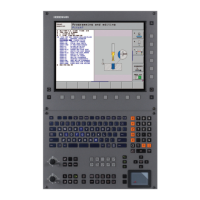HEIDENHAIN iTNC 530 497
19.1 Fundamentals
Entries in the tool table TOOL.T
Input examples for common tool types
Abbr. Inputs Dialog
CUT Number of teeth (20 teeth maximum) Number of teeth?
LTOL Permissible deviation from tool length L for wear detection. If the
entered value is exceeded, the TNC locks the tool (status L). Input
range: 0 to 0.9999 mm
Wear tolerance: length?
RTOL Permissible deviation from tool radius R for wear detection. If the
entered value is exceeded, the TNC locks the tool (status I). Input
range: 0 to 0.9999 mm
Wear tolerance: radius?
DIRECT. Cutting direction of the tool for measuring the tool during rotation Cutting direction (M3 = –)?
TT:R-OFFS Tool length measurement: Tool offset between stylus center and
tool center. Preset value: Tool radius R (NO ENT means R).
Tool offset: radius?
TT:L-OFFS Radius measurement: tool offset in addition to MP6530 between
upper surface of stylus and lower surface of tool. Default: 0
Tool offset: length?
LBREAK Permissible deviation from tool length L for breakage detection. If
the entered value is exceeded, the TNC locks the tool (status L).
Input range: 0 to 0.9999 mm
Breakage tolerance: length?
RBREAK Permissible deviation from tool radius R for breakage detection. If
the entered value is exceeded, the TNC locks the tool (status I).
Input range: 0 to 0.9999 mm
Breakage tolerance: radius?
Tool type CUT TT:R-OFFS TT:L-OFFS
Drill – (no function) 0 (no offset required because
tool tip is to be measured)
End mill with diameter of
< 19 mm
4 (4 teeth) 0 (no offset required because
tool diameter is smaller than
the contact plate diameter of
the TT)
0 (no additional offset
required during radius
measurement. offset from
MP6530 is used.)
End mill with diameter of
> 19 mm
4 (4 teeth) R (offset required because
tool diameter is larger than
the contact plate diameter of
the TT)
0 (no additional offset
required during radius
measurement. offset from
MP6530 is used.)
Radius cutter 4 (4 teeth) 0 (no offset required because
the south pole of the ball is to
be measured)
5 (always define the tool
radius as the offset so that
the diameter is not
measured in the radius)

